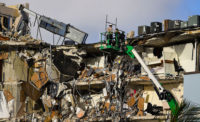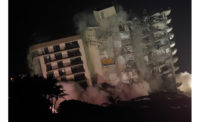Two months after a portion of the Champlain Tower South condominium in Surfside, Fla., suddenly collapsed, killing 98 people, the National Institute of Standards and Technology (NIST) on Aug. 25 announced the team of experts who will assist with the agency’s multi-pronged investigation into the tragedy.
Leading the investigation will be Judith Mitrani-Reiser, associate chief of the Materials and Structural Systems Division in NIST’s Engineering Laboratory, where she leads the development and coordination of statutory processes for making buildings safer, according to the agency. During an Aug. 25 online press briefing, Mitrani-Reiser noted that Miami is her “home town,” having grown up there.
Serving as the agency’s “associate lead” for the investigation will be Glenn Bell, co-director of the safety organization Collaborative Reporting for Safer Structures and co-founder of the American Society of Civil Engineers Technical Council on Forensic Engineering. He has previously investigated the 1981 the Hyatt Regency Hotel’s walkway collapse in Kansas City, Mo., and also supported NIST’s investigation of the collapse of the World Trade Center towers 1 and 2.
Mitrani-Reiser noted during the press briefing that other teams have been assembled to focus on specific issues to “give our investigation structure and help us identify and evaluate all possible causes of the partial collapse.” Five teams will separately focus on the Champlain Towers South building’s code history, evidence preservation, materials science, the structure’s geotechnical engineering and its structural engineering.
While noting that investigation team members were brought in for their “outstanding capabilities,” Mitrani-Reiser also credited them “for demonstrating in their careers a dedication to improving the safety of our built environment.” NIST may bring in other experts as the investigation continues.
This investigation will be the agency’s fifth initiated under authorities granted by the 2002 National Construction Safety Team Act. NIST officials made clear that they intend for the investigation to be exhaustive, and did not give a timeline for producing its findings.
“This will not be a quick process,” Mitrani-Reiser said. NIST’s most recent investigation, into Hurricane Maria’s impact on Puerto Rico, was launched in 2018 and is still ongoing.
In an exchange with journalists during the press briefing, Mitrani-Reiser noted if NIST investigators discover any issues that should be brought forward to protect the public safety, the agency will do so. However, the agency will not report any preliminary findings before issuing its final report on the technical cause, or causes, of the Champlain Towers collapse.
Said Mitrani-Reiser: “If indicated, (it) will include recommendations for improvements to our codes, standards and practice so that a tragedy like this never happens again.”






Post a comment to this article
Report Abusive Comment